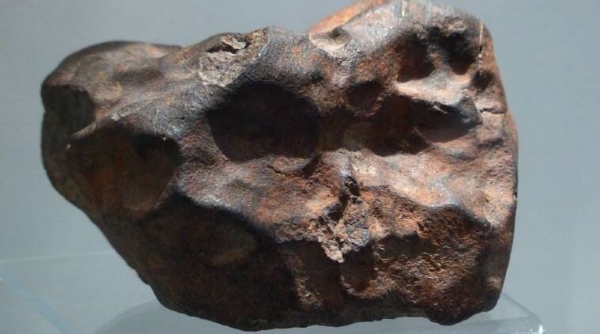Major discovery in cosmochemistry! Indian-origin scientist & team discovers graphene in two meteorites
Total Views |
New Delhi, June 02: In a major breakthrough in the illustrious history of carbon-focusing cosmochemistry, the scientist team involving Dr. Chaitanya Giri, ELSI Origins Network (EON) scientist at the Earth-Life Science Institute of Tokyo Institute of Technology, has discovered the signatures of a novel material, graphene in two meteorites. According to the research paper published in Planetary and Space Science, Nanoscale graphene was found embedded in refractory inclusions of two different CV3 meteorites, Allende and QUE 94366. This peer-reviewed study came out of research supported by the John Templeton Foundation.

What is graphene?
Graphene is the thinnest slice possible of graphite. Graphene consists of one-atom-thick layers of carbon atoms arranged in two-dimensional hexagons. It is one of the strongest and hardest materials. The material has many potential applications. It should be mentioned that the excitement surrounding graphene has only soared to dizzying heights since Andre Geim and Konstantin Novoselov were awarded the 2010 Nobel Prize in Physics for finding a method to isolate it.
This discovery has come nearly after a decade of NASA’s Johnson Space Center and the Carnegie Institution of Washington conducted discovery of whisker-shaped graphite embedded in two distinct meteorites.
About the discovery
These morphologies were found embedded in the refractory calcium-aluminum-rich inclusion (CAI) rims in Allende and within a chondrule inclusion in QUE 94366. As per Dr. Giri, the detected graphene could be as old as the calcium-aluminum-rich inclusions and perhaps synthesized in the inner protosolar nebula, dating around 4.5 billion years ago. “This is the first study to identify unambiguous Raman spectroscopic signatures of isolated graphene embedded in calcium-aluminum-rich meteoritic minerals that are considered to be as old as 4.5 billion years, older than all the planets in the Solar System," Giri said. Prior to this discovery, Graphene was only astronomically detected with telescopes around a dying star.
This discovery plays an important role in cosmochemistry as it provides physical evidence of the presence of naturally-formed graphene in extraterrestrial materials. Dr. Giri said that the detection will be considered as one of the stepping stones in the illustrious history of carbon-focusing cosmochemistry. "As cosmochemistry progressed with time, scientists were gradually finding carbon materials such as fullerenes, nanodiamonds, older-than-the-Sun (pre-solar) carbon, and graphite in meteorites. Our detection can be considered as one of the stepping stones in this illustrious history of carbon-focusing cosmochemistry,” Dr. Giri further stated.
Dr. Giri added that the graphene signatures detected here have all attributes of naturally-formed graphene than lab-made pristine graphene. Synthetic graphene is usually made in laboratories under controlled conditions because scientists usually know what they want to synthesize. He further said that the meteoritic graphene identified in the study has structural deformities: it is bent, twisted, curved, suspended, and has elemental impurities. These deformities are because nature, especially when it is in its harshest form in outer space, is not predetermined to form synthetic graphene.
According to the information given in the Planetary and Space Science Journal, this meteoritic graphene perhaps originated from the same protosolar carbon reservoir that synthesized the GWs. The graphene was most likely synthesized concurrent to the inclusions and CAIs, in a high-temperature zone near the proto-Sun and during the solar system's earliest eon.
The presence of carbon materials like graphene and graphite whiskers in the universe has been predicted by astrophysicists for more than fifty years. “Since the 1960s, a group of eminent astrophysicists from India and the United Kingdom had predicted the role of graphite whiskers in absorbing ambient heat from Type-1 supernovae, the blasts that occur at the terminal stages of some stars, and emitting heat slowly like glowing embers over long periods. The slow heat emission is known as Cosmic Microwave Background and many of us have felt it in an unsophisticated way as granular static on old-school antenna-connected TV sets. My co-authors, Andrew Steele and Marc Fries found similar whiskers’ first physical evidence in meteorites and lunar Apollo samples," Giri said.
Moreover, he defined that, "Graphite whisker resemble a single or a few sheets of paper rolled up unevenly and pulled out from its thinner end. If graphite whisker is akin to rolled-up paper, graphene is the sheets.”
Dr. Giri has further underlined the need to explore space saying, "A large natural reservoir of graphene will be of interest to cosmochemists and planetary scientists, and also to space startups and all these industries. It is important to comprehend, outer space is a treasure trove of exotic chemicals and materials. We must explore space for them and our curiosities and necessities.”
It should be noted that such carbon allotropes resemble morphologies that have been theorized to thermalize ambient radiation to generate the ~3 K microwave background.
The discovery of graphene in the meteorites hints at its presence in the minerals on carbonaceous asteroids, comets, and the Moon.
.
.